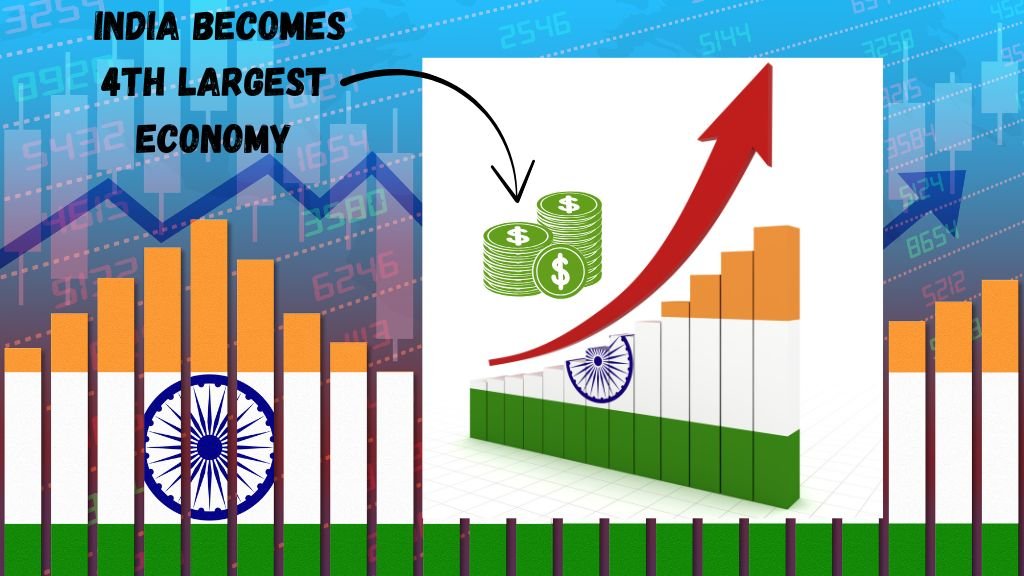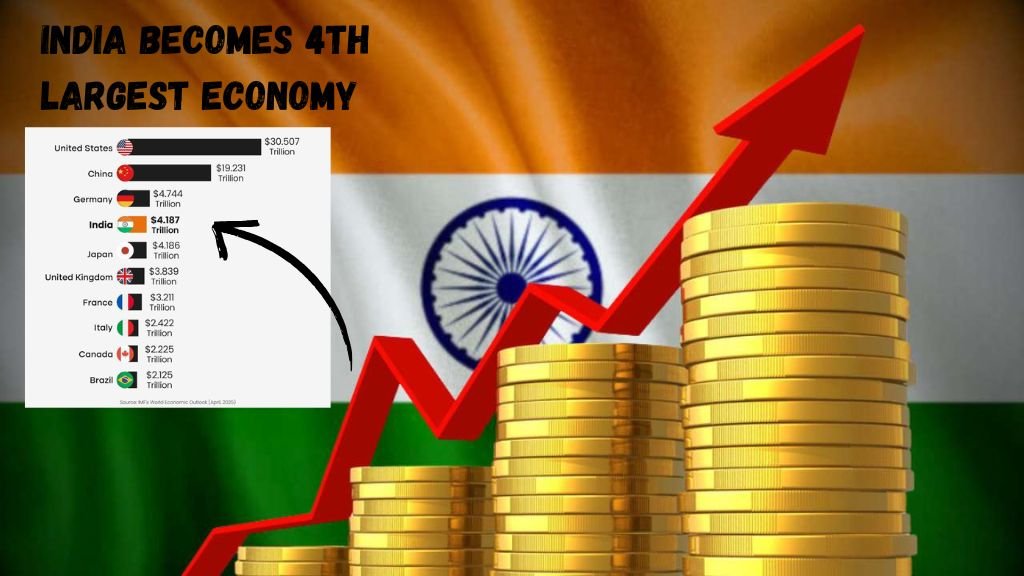India’s Economic Ascent in the Global Arena
India 4th Largest Economy–India’s journey from being labeled as one of the ‘fragile five’ economies a decade ago to emerging as the 4th largest economy in the world is a testimony to its remarkable economic transformation. Powered by structural reforms, resilient private consumption, and a burgeoning services and manufacturing sector, India has overtaken Japan to secure this historic position. As per the NITI Aayog CEO BVR Subrahmanyam, India has officially become the fourth largest economy, with a GDP surpassing USD 4 trillion. This achievement not only signifies India’s rising global influence but also reshapes the hierarchy of the largest economies in the world. The shift reflects India’s strategic reforms, growing digital infrastructure, youthful workforce, and an increasingly innovation-driven economic model.
India’s Journey to Becoming the 4th Largest Economy
From Fragile Five to the Top Five
Only a decade ago, India was grouped among the so-called “fragile five” economies — countries that were seen as vulnerable to capital outflows due to their high current account deficits and inflation. Fast forward to 2025, and India stands proudly as a global economic powerhouse. According to the International Monetary Fund (IMF) and statements made by NITI Aayog CEO BVR Subrahmanyam, India has overtaken Japan to become the 4th largest economy in nominal GDP terms. Subrahmanyam highlighted that, “India is a USD 4 trillion economy as I speak,” marking a significant leap in economic positioning.
Key Highlights from IMF and NITI Aayog
Economic Milestones and Projections
Indicator | Details |
Current Global Rank (2025) | 4th |
GDP (Nominal, 2025) | USD 4.19 trillion |
Country Surpassed | Japan (USD 4.187 trillion) |
Projected GDP Growth Rate (2025-26) | 6.2% |
Per Capita Income (2025) | USD 2,880 |
IMF Outlook | India to become 3rd largest economy by 2027 |
Global Growth Projection (2025) | 2.8% |
Global Growth Projection (2026) | 3.0% |
Long-term Goal | USD 30 trillion economy by 2047 |

Top 10 Largest Economies in the World by GDP (2025)
Understanding where India stands among the largest economies in the world requires a comparative look at other nations’ GDPs:
Rank | Country | GDP (USD Trillion) | GDP Per Capita (USD) |
1 | United States | $30.51 | $89,110 |
2 | China | $19.23 | $13,690 |
3 | Germany | $4.74 | $55,910 |
4 | India | $4.19 | $2,880 |
5 | Japan | $4.19 | $33,960 |
6 | United Kingdom | $3.83 | $54,950 |
7 | France | $3.21 | $46,390 |
8 | Italy | $2.42 | $41,090 |
9 | Canada | $2.23 | $53,560 |
10 | Brazil | $2.13 | $9,960 |
What Makes India’s Rise Unique?
Demographic Dividend and Consumption Power
India’s population, now the largest in the world, gives it a unique edge — a young, tech-savvy, and aspirational workforce. Rural consumption, in particular, has been a strong pillar of economic stability. According to the IMF, private consumption—especially from rural areas—is a major growth driver.
Strategic Reforms and Government Initiatives
From GST implementation to PLI schemes, India has undertaken significant structural reforms that have simplified doing business and attracted foreign investment. Moreover, government-backed initiatives like Digital India, Startup India, and Make in India have accelerated economic transformation.
Strong Services and Manufacturing Base
India has made tremendous progress in both the IT sector and industrial production. The services sector alone contributes over 50% to GDP, with rapid growth in fintech, edtech, and e-commerce, while manufacturing is on a steady rise due to global supply chain diversification.
IMF’s Outlook- What Lies Ahead for India?
According to the IMF World Economic Outlook 2025, India’s GDP is projected to grow at 6.2% in 2025–26. While this is slightly slower than earlier forecasts of 6.5%, it still represents one of the highest growth rates among major economies.
“For India, the growth outlook is relatively more stable at 6.2 percent in 2025, supported by private consumption, particularly in rural areas,” said the IMF report.
Economic Milestones- A Decade of Transformation
Key Economic Indicators for India (2014–2025)
Year | Nominal GDP (USD) | Global Rank | Per Capita Income (USD) |
2014 | $2.04 trillion | 10th | $1,438 |
2019 | $2.87 trillion | 7th | $2,100 |
2024 | $3.73 trillion | 5th | $2,600 |
2025 | $4.19 trillion | 4th | $2,880 |
In just over a decade, India has doubled its per capita income and risen six ranks on the global GDP leaderboard. The significance of this transformation becomes even clearer when seen in the global context.
Future Projections- India as the 3rd Largest Economy by 2027?
The IMF and NITI Aayog believe that if India maintains its growth momentum, it could overtake Germany and become the third largest economy in the world by 2027. This would require sustained annual growth of over 6% and continued reforms in sectors like infrastructure, education, labor, and technology.
NITI Aayog’s Vision for Viksit Bharat @2047
The recently published NITI Aayog paper titled “Viksit Bharat @2047” outlines India’s aspirations of becoming a USD 30 trillion economy by its 100th year of independence. This vision includes comprehensive reforms and strategies under six major building blocks:
Key Building Blocks for India’s Development:
- Macro-Economic Goals and Strategy
- Empowered Citizens
- A Thriving and Sustainable Economy
- Technology and Innovation Leadership
- Global Leadership (Vishwa Bandhu)
- Governance, Security, and Justice Delivery
The goal is to transition into a developed, high-income country by 2047, with a per capita income exceeding USD 14,000, thereby entering the ranks of high-income nations as defined by the World Bank.
India’s Challenges on the Road Ahead
Despite the optimistic projections, India must address certain critical challenges:
Escalated Global Trade Tensions
As highlighted in the IMF’s World Economic Outlook, global uncertainties and geopolitical shifts could impact India’s export-led sectors. Navigating international trade disruptions will require agile diplomacy and trade diversification.
Infrastructure and Employment
To support a $30 trillion economy, India needs massive investments in infrastructure, particularly in urban planning, logistics, and energy. Additionally, creating millions of quality jobs will be crucial to leverage the young population.
Climate Resilience and Sustainability
As the global economy becomes more environment-conscious, India must balance growth with sustainable practices, transitioning to cleaner energy sources and embracing green technologies.

Why India’s 4th Place is More Than Just a Number
India’s move to the 4th largest economy in the world isn’t just symbolic—it reshapes how the world perceives emerging markets. It marks the start of a new era where India is not just a participant but a key driver of global economic trends. As global companies look for alternatives to China, India stands to benefit massively from reshoring and diversification. Moreover, as global financial institutions revise investment strategies, India’s inclusion in their top portfolios will become increasingly common.
India in the Context of Global Growth
Comparative Growth Outlook
Country | Projected Growth Rate (2025-26) |
India | 6.2% |
China | 4.6% |
United States | 2.3% |
Germany | 1.2% |
Japan | 1.0% |
India’s projected growth rate far exceeds that of other major economies, reflecting resilience and potential for further advancement.
Looking Ahead- India Among the Top 3 by 2027?
According to NITI Aayog and the IMF, if India maintains its current momentum, it is on track to overtake Germany by 2027, becoming the 3rd largest economy in the world. This will place India right behind only the United States and China.
Strategic Priorities to Reach the Top 3-
- Accelerate digital transformation
- Expand high-value manufacturing
- Improve human capital and education
- Strengthen financial institutions and credit systems
- Enhance global trade partnerships
Global Economic Landscape- A Brief Comparison
India’s ascent also shifts the global balance of power. Here’s how the world’s largest economies compare in 2025:
World Largest Economies – Key Comparisons
Country | GDP (USD) | Growth Rate (%) | Global Role |
USA | $30.51 trillion | ~2.2% | Largest consumer economy, tech leader |
China | $19.23 trillion | ~4.6% | Manufacturing powerhouse |
Germany | $4.74 trillion | ~1.4% | Industrial and export leader |
India | $4.19 trillion | 6.2% | Fastest-growing major economy |
Japan | $4.19 trillion | ~1.1% | Aging population, economic stagnation |
Frequently Asked Questions (FAQs)
Q1: What is India’s GDP in 2025?
A: According to the IMF, India’s nominal GDP in 2025 is estimated at $4.19 trillion.
Q2: Which countries are ahead of India in GDP rankings?
A: Only the United States, China, and Germany are currently ahead of India.
Q3: What is India’s rank among the top economies in the world?
A: India is ranked as the 4th largest economy in the world as of 2025.
Q4: What is the target for India by 2047?
A: India aims to become a $30 trillion economy and a high-income country by 2047.
A Defining Moment for India and the World
India’s elevation to the 4th largest economy is not just a significant national milestone but a global event. As the nation celebrates this achievement, the world acknowledges India’s growing stature in geopolitics and economics. From poverty alleviation to technological innovation, India’s model is increasingly being studied and emulated. With focused policies, continued reforms, and inclusive development, India is poised to not just remain among the top 5 economies in the world, but to become one of the world’s largest economies in the next decade. The journey from fragile five to economic superpower illustrates India’s unwavering commitment to growth, stability, and transformation.







